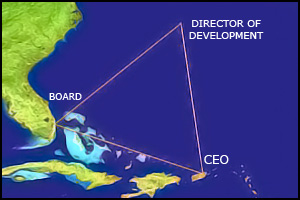The Development Bermuda Triangle
 I get asked this question many times: Why is there such high turnover in the Director of Development position? My answer: The Development Bermuda Triangle.
There are three key positions of power and influence in a nonprofit organization regarding development - the board, the CEO, and the DD (Director of Development). When there is a conflict, guess who disappears without a trace? Not the board. Not the CEO, but the DD.
Let's take a look at some of the reasons why, considering the causes or motivations of conflict between these three positions, and in what situations this may occur.
I get asked this question many times: Why is there such high turnover in the Director of Development position? My answer: The Development Bermuda Triangle.
There are three key positions of power and influence in a nonprofit organization regarding development - the board, the CEO, and the DD (Director of Development). When there is a conflict, guess who disappears without a trace? Not the board. Not the CEO, but the DD.
Let's take a look at some of the reasons why, considering the causes or motivations of conflict between these three positions, and in what situations this may occur.
- A conflict in expectations. This is the most frequent conflict as it can involve any or all of the three parties. Board members may have an expectation of how much money YOU can raise this year. (That alone spells trouble.) A CEO may have personally overseen the development programs (for good or bad) and have expectations of the new DD as they "wash their hands" of development. The new DD may have expectations of getting to know people, or building a solid development strategy, or other professional expectations and may or may not be aware of the board and CEO expectations. Who disappears without a trace? The DD!
- A conflict in development philosophy. Many times one of the parties will have a philosophy that whatever brings in money is the goal. Others might have more of a focus on relationships. Still another might be about stewardship and the spiritual focus of the donor. And still others might be – show me the money! As you can see, the philosophy is a key motivator in the life of a DD. If the DD has studied stewardship and wants to install this philosophy it can take some time. If the board or CEO is very impatient, they may not be patient enough to wait for "relationships". I have had a client say after 3–4 months starting a campaign, "your ministry of development lingo hasn't brought in any money yet". I walked away from that project immediately. If the philosophy or the "why" of what the DD is motivated by is not on the same page as the board and CEO, expect another "disappearance" of the DD.
- A conflict in power between CEO and DD. The DD talks to everyone, both internally and externally. They are usually people who like to know what is going on inside the organization and are at ease with people in the community. If the CEO is in anyway insecure or unsure about his/her reputation in the community, or just uncomfortable with the style of the DD, there can be a conflict of power in the organization. This power is hard to define. The CEO is still in control, but may feel donors listen to the DD more than they listen to them. The worst is when a board member(s) quotes the DD at a board meeting and implies they are following the DD's leadership more so than the CEO leadership. This is the kiss of death. The DD will disappear shortly thereafter. There can be no sharing of power if the CEO and DD do not understand and accept their proper roles (which is a different article).
- A conflict in board/CEO involvement in development. Board involvement in development can vary greatly. Some understand their role in development from when they are recruited. But I still have board members who say to their DD when asked to be involved in some development strategy, "Me be involved? That's why we hired you!" If there is this much distance between the board learning their role and the job description of the DD, the DD will disappear shortly thereafter.
These are just a few of the conflicts that cause the DD to "disappear without a trace." It is disappointing and frustrating when this happens. A board and/or CEO may have invested a great deal of time and money in finding the right DD. A DD may have a passion to help the organization but cannot get past the walls put up by the board and/or CEO. No one seems to be the winner when the DD is lost to the Development Bermuda Triangle. My advice is not to re-fill the position until the organization steps back and analyzes why it did not work the previous time. Repeating the same process without looking at the problems, who caused them, how to solve them, etc. is a foolish endeavor. The DD position is hard to fill and it's even harder to create a team that lasts a long time. By looking at the Development Bermuda Triangle it may be possible to learn how to solve some of these problems before you bring in the next victim, er, candidate!
